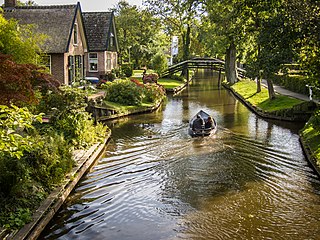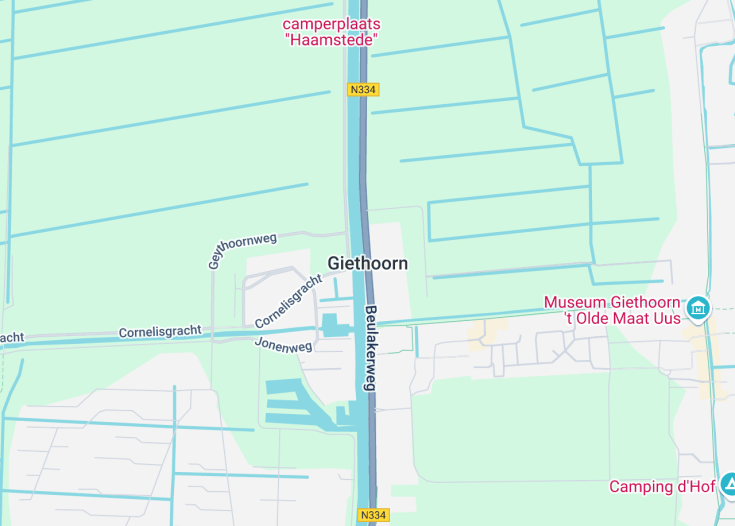Giethoorn, often referred to as the “Venice of the North,” is a picturesque village in the Netherlands renowned for its idyllic waterways, quaint thatched cottages, and absence of roads. This enchanting village offers a peaceful escape, with whisper-quiet electric boats gliding along its canals, and lush greenery enhancing its storybook charm.
Giethoorn provides a unique opportunity to step back in time and experience a serene, car-free lifestyle, making it a perfect destination for those seeking tranquility and natural beauty.
To make the most of your Giethoorn visit, consider renting a boat early in the day to avoid crowds and fully enjoy the peaceful waterways.
Plan your trip during spring or early autumn to experience Giethoorn’s scenic beauty with fewer tourists and mild weather conditions.
Top things to do & see in Giethoorn
Select the following sights and activities to discover best tickets and tours available in Giethoorn.
Giethoorn: The Venice of the North
| Country | Netherlands |
| Time in Giethoorn | GMT+1 |
| Language spoken | Dutch |
| Population | 2,620 (source: latest municipal data) |
| Currency | Euro (€, EUR) |
| Airports |
|
Giethoorn, a picturesque village in the province of Overijssel in the Netherlands, often evokes images of a serene, fairy-tale world. Known globally as the “Venice of the North,” Giethoorn is distinguished by its boat-filled waterways, charming wooden bridges, and beautifully preserved thatch-roofed houses. Founded around the 13th century by Franciscan monks, the village’s name derives from the numerous goat horns (‘Gietehorens’) discovered in the area, left behind after a flood devastated the local wildlife.
What makes Giethoorn truly unique is the absence of roads in the old part of the town, where all transport is done by water over the vast, picturesque canals. The tranquil boat rides give visitors a magical experience, offering unrivaled views of the lush green landscapes and historic homes lining the canals. Over the years, Giethoorn has become incredibly popular with tourists seeking a quiet getaway in a stunning natural setting, away from the clatter of city life.
In addition to its natural beauty and peaceful way of life, Giethoorn also hosts several cultural events and festivals that showcase traditional Dutch crafts and folklore. The village keeps its culture alive by celebrating its history and embracing the slow pace of country living, making it a perfect escape into the past.
Where is Giethoorn?
Giethoorn is nestled in the northeastern part of the Netherlands, surrounded by the Weerribben-Wieden National Park.
Distances:
| Route | Distance by car | Time by car |
|---|---|---|
| Amsterdam to Giethoorn | 83 miles / 133 kilometers | Approximately 1 hour 30 minutes |
| Rotterdam to Giethoorn | 134 miles / 215 kilometers | Approximately 1 hour 50 minutes |
| Groningen to Giethoorn | 53 miles / 85 kilometers | Approximately 1 hour |
What is Giethoorn famous for?
Giethoorn is renowned for its extensive and beautiful canal system as well as its picturesque and traditional Dutch rural architecture. This unique car-free village provides an idyllic pastoral setting that attracts visitors from all over the globe.
History
1200s – Early Settlement
The story of Giethoorn began in the 1200s when Franciscan monks arrived in the region. They discovered numerous horns of wild goats, which had probably died during the 1170 flood. This led to the naming of the town “Giethoorn,” which means “goat horns” in Dutch. The monks created the first canals to transport peat which defined the settlement’s structure.
1600s – Peat Extraction Era
During the 1600s, Giethoorn gained prominence for its peat extraction. Peat mining became the pillar of Giethoorn’s economy, shaping the landscape with extensive canals and ponds as byproducts of extraction methods. This period marked an economic boom as peat was a valuable resource for fuel.
1800s – Agricultural Development
By the 1800s, after the depletion of peat reserves, Giethoorn started to shift towards agriculture. The canal system originally used for peat transport seamlessly facilitated the irrigation of fields. Farming of crops and dairy production became predominant, which reshaped Giethoorn into a modest, community-focused agricultural village.
1900s – Rise in Tourism
The 1900s brought a pivotal shift to tourism in Giethoorn when it was featured in a popular Dutch film, “Fanfare” (1958). The town’s picturesque scenery, thatched-roof cottages, and serene canals captured the heart of the audience. This media exposure pivoted Giethoorn from a quiet village to a sought-after tourist destination.
2000s – Present: International Recognition
In the 21st century, Giethoorn has embraced its status as a major international tourist destination. Known as the “Venice of the North,” it offers a tranquil escape from urban life and provides unique experiences like boat tours in its extensive canal network. Preservation efforts are critical to maintaining its heritage and environment amidst growing tourism.
Visit Giethoorn
What to see and do in Giethoorn
Giethoorn offers an enchanting escape into a village where nature and culture intertwine gracefully. Key attractions include:
- Canal Tours: Explore the labyrinth of canals by renting a whisper boat or joining a guided tour.
- Museum Giethoorn ‘t Olde Maat Uus: This museum gives insights into the historical way of life in the region.
- De Oude Aarde: Admire a stunning collection of gemstones and minerals at this museum.
- Walking and cycling: The surrounding natural reserves, like Weerribben-Wieden, offer ample opportunities for walking and cycling along picturesque paths.
Festivals and Events in Giethoorn
Giethoorn hosts various cultural events throughout the year, enhancing its allure:
- Giethoorn Music Festival (Summer): A celebration of classical and contemporary music held every August.
- Giethoorn Winter Weeks (December-January): Features winter sports like ice skating on the frozen canals followed by cozy gatherings.
Best time to visit Giethoorn
The ideal time to visit Giethoorn is from late spring to early autumn (May to September), when the weather is favorable for canal tours and outdoor activities.
Is Giethoorn worth visiting?
Giethoorn is undoubtedly worth visiting for those who seek a serene getaway immersed in a picturesque setting.
The unique water-centric lifestyle and the peaceful rural environment offer a rare blend of tranquility and beauty, making it an enchanting destination for tourists seeking both relaxation and adventure in a singular locale.









